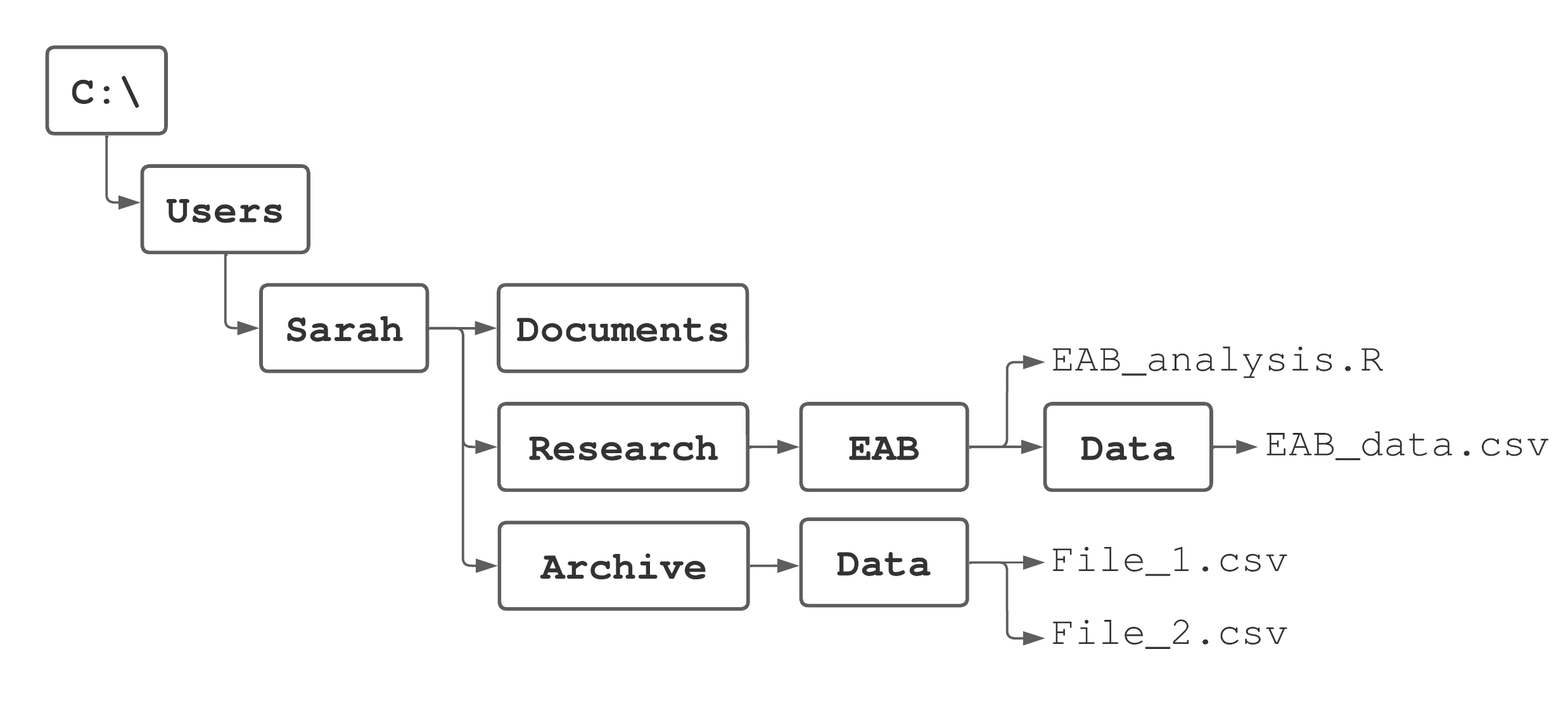Intro to Practical Computing
Agenda
- Review
- Naming best practices
- Files and directories
Last week
- Syllabus
- Lab 1
- Tools for the course:
R, RStudio, and Quarto
Syllabus
- Recall lecture tickets are due in person at the beginning of lecture.
- Course late policy has been added to online version.
- Let’s quickly review the late policy.
www.for128.org/syllabus.html
Lab 1
- If you’re having troubles, technical or otherwise, come to office hours.
- Make sure to turn in (.pdf and .qmd) to D2L by 5pm on Wednesday (tomorrow).
Data Science Tools
Ris a programming language.- RStudio is an IDE (what we use to interact with
Rand our computer). - Quarto is a markdown language, for writing reports.
- You, the chef

Image credit: The Culinary School of Fort Worth
R, the ingredients

Image credit: foodandwine.com
- RStudio, your kitchen

Image credit: Country living magazine
- Quarto, the plated final product

Image credit: budgetbytes.com
Practical computing
Practical computing
Understanding your computer and its file system is vital to success in this class and beyond.
Last week, we threw you into the deep end with data science tools.
This week, we’ll spend a bit more time on the details to help you interact with your computer and these tools.
Today, we’ll focus on file systems and file/folder naming.
Naming files and folders
Some best practices are important for naming files and folders:
- Use consistent casing:
- delimiter naming, e.g.
lab_01.qmdorcat_pictures - camel case, e.g.,
finalProjectMaterials.qmdorcatPictures
- delimiter naming, e.g.
- Name your files and folders clearly, concisely, and informatively:
- Good:
for128_f24 - Bad:
my_work_for_forestry128_in_fall_2024 - Really bad:
myWorkFor_forestry128_inFall_2024
- Good:
File systems / directories
- Every time you create or download a file, you are storing it somewhere in your computer’s file system.
- But where? 🤔
File systems / directories
- Think of your computer’s file system as a tree

The root
The root directory is the start or base of your file system.
- On Windows, the root is
C:/ - On macOS and Linux, the root is
/
Your home directory
When interacting with your computer, you are logged in as a user. Each user has a home directory.
For example:
- On Windows,
C:/Users/Sarah - On macOS and Linux,
/home/sarah
Your home directory
It is often easier to use a shortcut to access your home directory: ~. On Windows, macOS, and Linux, you can use ~ to access your home directory:
~is equivalent toC:/Users/Sarahand/home/sarah
Paths
C:/Users/Sarah and /home/sarah are examples of paths. In particular, these are paths to Sarah’s home directory.

Paths
- Paths specify the location of a file or folder on your computer, let’s look at a few examples:
//home/sarah/home/sarah/Desktop/home/sarah/Documents/for128/lab_01.qmd~/Documents/for128/lab_01.qmd
Paths
- Equivalent paths, on Windows:
C:/C:/Users/SarahC:/Users/Sarah/DesktopC:/Users/Sarah/Documents/for128/lab_01.qmd~/Documents/for128/lab_01.qmd
Relative vs. absolute paths
- So far, we’ve only shown absolute paths.
- Absolute paths show a file or folder in reference to your computer’s file system.
- Relative paths, on the other hand, show a file or folder in relation to a working directory.
Working directory example
- Recall the absolute path to
lab_01.qmd:/home/sarah/Documents/for128/lab_01.qmd
- Say our working directory is the documents folder:
/home/sarah/Documents
- Then the relative path to
lab_01.qmdis:for128/lab_01.qmd
Use relative (not absolute) paths!
Why?
- Reproducibility!
- They will work on any computer, not just your own.
- Clear and concise.
- But really, reproducibility.
Working directories in Quarto and R demo
What have we learned?
- In Quarto, the default working directory is the folder where the quarto document lives.
- Crucial note: this may be different than the working directory in your R console.
- You can set your working directory in
Rwithsetwd()- Just for your
Rconsole, though. This does not apply to Quarto documents.
- Just for your
- You can get your current working directory in
Rwithgetwd()
Next time
- Remember, lab 1 is due tomorrow at 5pm on D2L.
- RStudio projects.
- Reading and writing data.